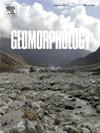Measuring beach pebbles and cobbles abrasion with RFID technology on a mixed sand and gravel beach, South Island, New Zealand
IF 3.1
2区 地球科学
Q2 GEOGRAPHY, PHYSICAL
引用次数: 0
Abstract
The measurement of in situ abrasion has been investigated since the early 20th Century and it is thought to represent a significant loss from coastal sediment budgets of some mixed sediment beaches. Traditional methods of tracking pebbles or cobbles to assess abrasion have numerous shortcomings, however, Radio Frequency Identification (RFID) now makes it feasible to track and relocate tagged particles on a beach. In this study, RFID was used to quantify pebble and cobble abrasion on a mixed sand and gravel beach, South Island, New Zealand. A total of 228 greywacke pebbles and cobbles were tagged and released on two occasions on the study beach. Some of these pebbles and cobbles were relocated on the first two days after release and then again at intervals of months with a maximum recovery period of 15 months. Particles were weighed each time they were relocated to assess abrasion and their positions recorded to calculate the distance travelled from the initial release point. The mean daily abrasion rate of pebbles and cobbles was 0.02 %/day in weight, equivalent to 7.30 %/year in weight. A significant correlation was found between abrasion and transport distance and wave energy. These results contribute to the small database of abrasion rates for mixed sediment beaches. The study also provides detailed data on cross-shore and alongshore displacement, as well as burial depth. Comparison with previous studies from around the world suggests that a universally applicable abrasion rate for all mixed beaches is unattainable.
在新西兰南岛的混合沙砾沙滩上,用射频识别技术测量沙滩卵石和鹅卵石的磨损
自20世纪初以来,人们对原位磨损的测量进行了研究,认为它代表了一些混合沉积物海滩的海岸沉积物预算的重大损失。跟踪鹅卵石或鹅卵石来评估磨损的传统方法有许多缺点,然而,无线射频识别(RFID)现在使跟踪和重新定位海滩上的标记颗粒成为可能。在这项研究中,RFID被用于量化新西兰南岛混合沙和砾石海滩上的鹅卵石和鹅卵石磨损。在研究海滩上,总共有228块灰尾石和鹅卵石被标记并两次释放。其中一些鹅卵石和鹅卵石在释放后的头两天被重新安置,然后每隔几个月重新安置一次,最长恢复期为15个月。每次重新放置颗粒时,对其进行称重以评估磨损,并记录其位置以计算从初始释放点移动的距离。鹅卵石和鹅卵石的平均日磨损率为0.02% /天,相当于7.30% /年的重量。磨损与输运距离和波能之间存在显著的相关关系。这些结果有助于建立混合沉积物海滩磨损率的小型数据库。该研究还提供了有关跨海岸和沿海岸位移以及埋藏深度的详细数据。与以往世界各地的研究比较表明,一个普遍适用于所有混合海滩的磨损率是不可能达到的。
本文章由计算机程序翻译,如有差异,请以英文原文为准。
求助全文
约1分钟内获得全文
求助全文
来源期刊

Geomorphology
地学-地球科学综合
CiteScore
8.00
自引率
10.30%
发文量
309
审稿时长
3.4 months
期刊介绍:
Our journal''s scope includes geomorphic themes of: tectonics and regional structure; glacial processes and landforms; fluvial sequences, Quaternary environmental change and dating; fluvial processes and landforms; mass movement, slopes and periglacial processes; hillslopes and soil erosion; weathering, karst and soils; aeolian processes and landforms, coastal dunes and arid environments; coastal and marine processes, estuaries and lakes; modelling, theoretical and quantitative geomorphology; DEM, GIS and remote sensing methods and applications; hazards, applied and planetary geomorphology; and volcanics.
 求助内容:
求助内容: 应助结果提醒方式:
应助结果提醒方式:


